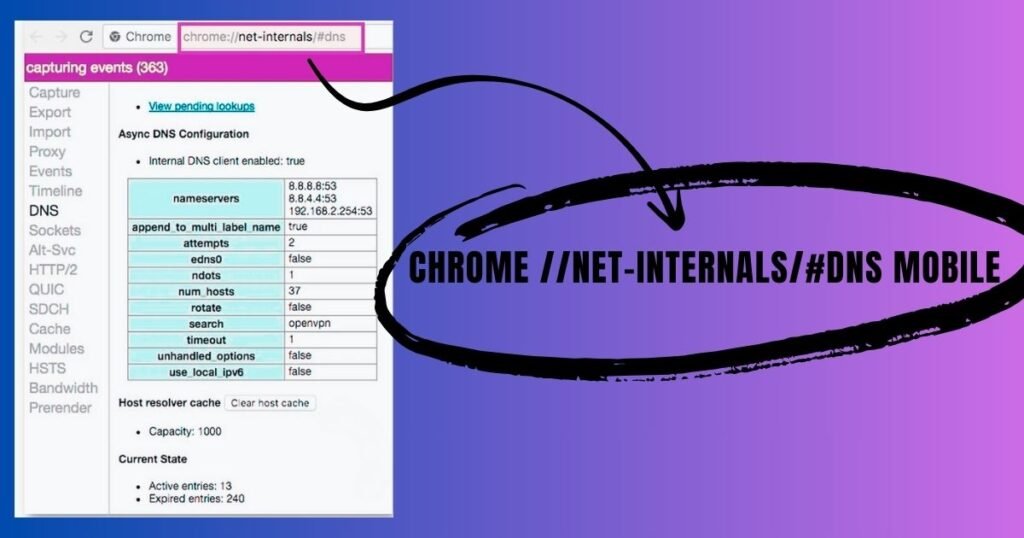Introduction
Versatile perusing has become a significant part of our life in the ongoing computerized period. Internet browsers are persistently changing to give better client encounters because of the developing utilization of cell phones. Google Chrome is a prominent web browser with a potent feature called “chrome://net-internals/#dns mobile”. In this article, we will examine what this element involves and how it can further develop your versatile perusing experience.
Chrome://net-internals/#dns is an inner page inside Google Chrome that gives essential bits of knowledge into the Space Name Framework (DNS), a central part of the web. DNS translates human-readable domain names into IP addresses, a process crucial for accessing websites.
As mobile devices frequently switch between networks and internet connections, they can encounter DNS-related challenges, leading to slow page loads and failed accesses. Chrome://net-internals/#dns mobile offers users the means to diagnose and rectify these DNS issues, enhancing the overall mobile browsing experience.
What is Chrome //net-internals/#dns?
Chrome://net-internals/#dns is an internal Google Chrome page called dns that offers helpful details about how the Domain Name System (DNS) functions. Comprehensible space names are changed over into IP addresses by DNS, a pivotal component of the web. When you enter a URL in the location bar, Chrome asks DNS servers for the significant IP address of the site you wish to visit.
Why is it essential for browsing on mobile devices?
Mobile devices frequently switch between several internet connections and networks. This ongoing modification can occasionally result in DNS-related problems, such as lengthy loading times and unsuccessful page loads. Users can identify and fix these DNS issues using Chrome://net-internals/#dns, which enhances mobile surfing experiences.

Steps to Access chrome://net-internals/#dns mobile
Follow these steps to access chrome://net-internals/#dns mobile:
- On your cell phone, utilize the Google Chrome program.
- Enter “chrome://net-internals/#dns” into the location bar.
- The internal page will load and show different DNS-related data.
Compatibility with Multiple Mobile Devices :
Most Android and iOS devices running the most recent version of Google Chrome are compatible with Chrome://net-internals/#dns mobile. For seamless access to this feature, make sure your copy of Chrome is the most recent update.
Investigating DNS Information
You may discover useful information about DNS queries and cache at chrome://net-internals/#dns mobile. Your ability to identify and fix any problems with your mobile browsing will increase when you comprehend this information.
Interpreting the information shown by Chrome //net-internals/#dns
The information contains specifics regarding previous DNS queries, cached records, and the current state of each DNS activity. You can tell whether or not a specific website’s DNS resolution is working correctly.
Troubleshooting DNS problems on mobile
You can use this function to troubleshoot DNS-related problems when you discover any anomalies in the DNS data or experience difficulty with particular websites. Such issues may be fixed by deleting DNS cache or changing DNS settings.
DNS Settings for Mobile Optimization :
Effective DNS settings can considerably impact your mobile surfing performance and speed. The following advice can help you improve your DNS settings:
Enhancing the performance and speed of mobile browsing –
- Use trustworthy DNS servers from dependable suppliers.
- Consider using public DNS servers like Google Public DNS or Cloudflare DNS for improved speed.
- Avoid configuring the configuration with too many DNS servers, which can cause delays.
Deleting DNS cache on mobile Chrome –
To ensure that your mobile device retrieves the most recent IP address for websites, you should regularly clear the DNS cache. Follow these instructions to delete the DNS cache on Chrome for mobile:
- Chrome should now be open, so go to “chrome://net-internals/#dns”.
- By choosing “Clear host cache,” the DNS cache will be cleared.
Considerations for Privacy and Security
Security and privacy are crucial for any function dealing with network data. What you need to know about chrome://net-internals/#dns mobile is as follows:
Is the information in chrome://net-internals/#dns secure for mobile?
The information available at chrome://net-internals/#dns mobile is for diagnostic use only and is not detrimental to the security of your browsing session. Sharing this knowledge with others, nevertheless, should be done with discretion.
Recognizing the implications for privacy
The Chrome://net-internals/#dns mobile page offers comprehensive information about your surfing habits. Awareness of any privacy issues is crucial, especially when utilizing shared or public devices.
Additional Configurations
Advanced configuration options are available for people with a greater understanding of DNS and networking on mobile at chrome://net-internals/#dns:
DNS configuration for advanced users
Advanced users can configure particular DNS servers or manually test out various settings. This capability enables more precise management of the DNS resolution procedure.
Potential dangers and advantages
Sophisticated configurations provide more flexibility, but there are also possible hazards. Connectivity problems or security flaws may result from incorrect settings. When making adjustments to these settings, proceed with caution.
Experimental Features and Chrome Flags
Some of the experimental features that Google Chrome frequently makes available via chrome://flags might be DNS-related:
Investigating more experimental features
For any experimental functionality involving DNS or mobile browsing, visit chrome://flags. Early access to new features may be possible by experimenting with these features.
How to safely turn them on/off
Before enabling any experimental features, consider the potential effects on performance and stability. Disable the feature or return to normal settings if you experience problems.
Conclusion :
A robust tool that enables users to analyze and change their DNS settings for better mobile surfing experiences is available at chrome://net-internals/#dns mobile. Users may increase browsing performance, solve problems, and guarantee a secure browsing environment by comprehending the data and making intelligent configurations.
Chrome://net-internals/#dns mobile is a powerful tool within the Google Chrome browser that empowers users to take control of their mobile browsing experience. It offers valuable insights into DNS functionality, allowing users to troubleshoot and optimize their DNS settings for enhanced performance and faster loading times on mobile devices. By leveraging this tool, users can identify and resolve DNS-related issues, clear DNS caches for updated website access, and even explore advanced configuration options for precise control.
